The Powerful Impact of Using WhatsApp for Customer Engagement
Published on May 21, 2024/Last edited on May 21, 2024/8 min read
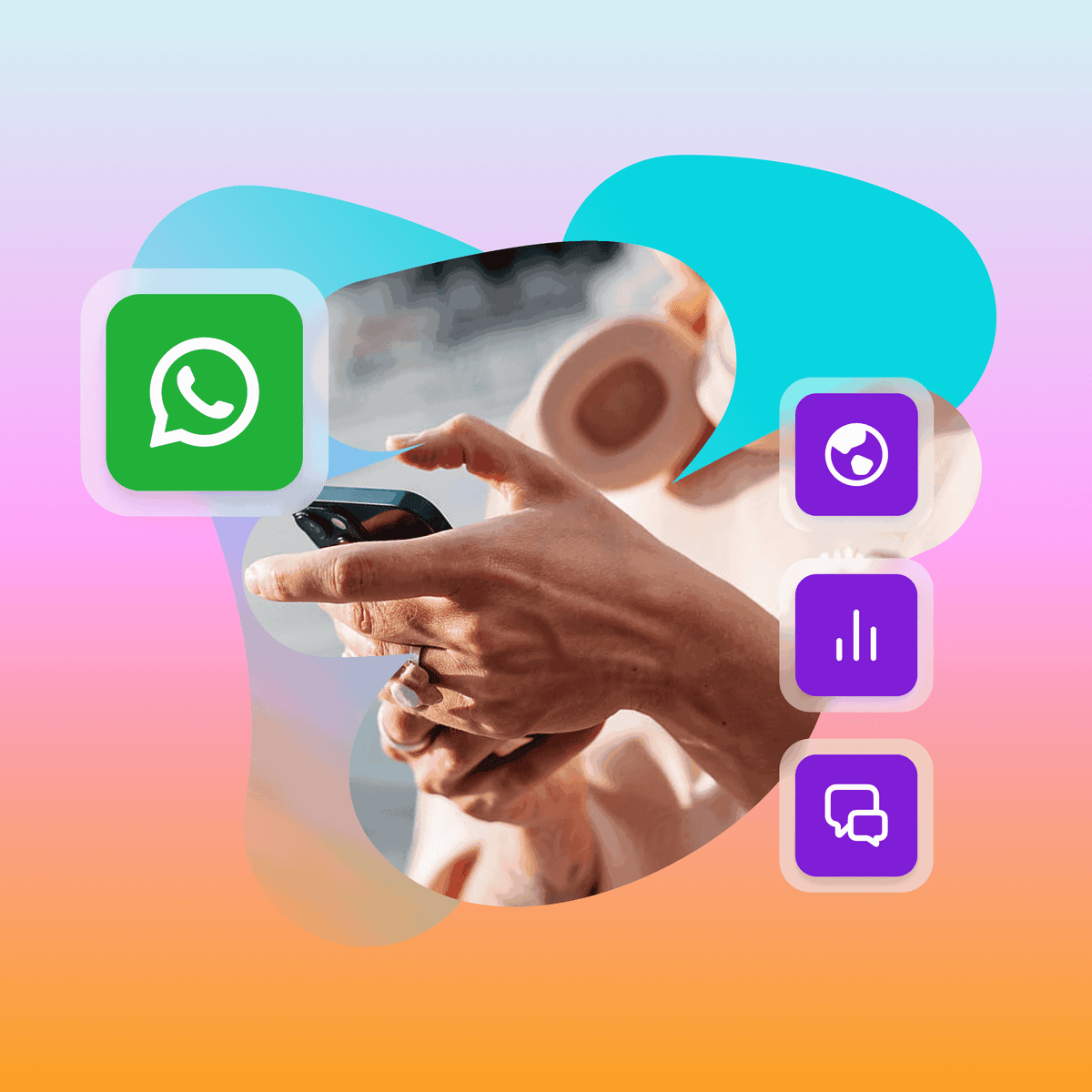
Brandon Liu and Lexie Haggerty
WhatsApp is a vital channel for brands looking to drive deeper engagement with customers around the globe. After all, it’s the most popular mobile messaging app in the world, with over 2 billion monthly active users. Boasting a penetration rate of over 85% in parts of Latin America, Asia Pacific, and Europe, it’s a channel that’s integrated into the everyday lives of consumers, making it perfect for marketers looking to connect with customers in a way that feels seamless and authentic.
Braze launched native support for WhatsApp in March 2023, enabling brands to send real-time, two-way messaging at scale. Our customers have increasingly embraced the channel, growing their combined messaging volume by 70X (i) since then, while also seeing strong results that are driving impact across the customer lifecycle. To determine just how effective the channel is in connection with key marketing metrics like engagement, purchases, and retention, we’ve analyzed the impact of WhatsApp messaging (and its inclusion in other cross-channel campaigns) on key KPIs like sessions, average user lifetime, purchases per user, retention, and more. We looked at customers across a variety of company sizes and industries to see how this dynamic channel can move the needle for a wide range of brands.
In this blog, we’ll explore:
- Why marketers are increasingly adopting WhatsApp
- How WhatsApp stacks up against other marketing channels
- The impact of WhatsApp when used as part of a cross-channel engagement strategy
- How WhatsApp’s rich conversational capabilities boost performance
WhatsApp is increasingly being adopted by marketers as they recognize the channel’s value
WhatsApp is a rapidly growing channel among direct-to-consumer (D2C) marketers. Once users have opted-in to receive marketing messaging on the channel, their engagement is high, with an average read rate on marketing messages of 68%.
We recently surveyed 1,900 marketers and asked which channels they are using (or plan to use) in 2024. Messaging apps like WhatsApp rose to the top of the list this year, with 47% of surveyed marketers indicating they plan to use this dynamic channel to reach customers. Compare this to the 45% of respondents who indicated that they’re using or planning to use email, 43% for mobile and web push, and 40% for in-app and in-browser messaging.
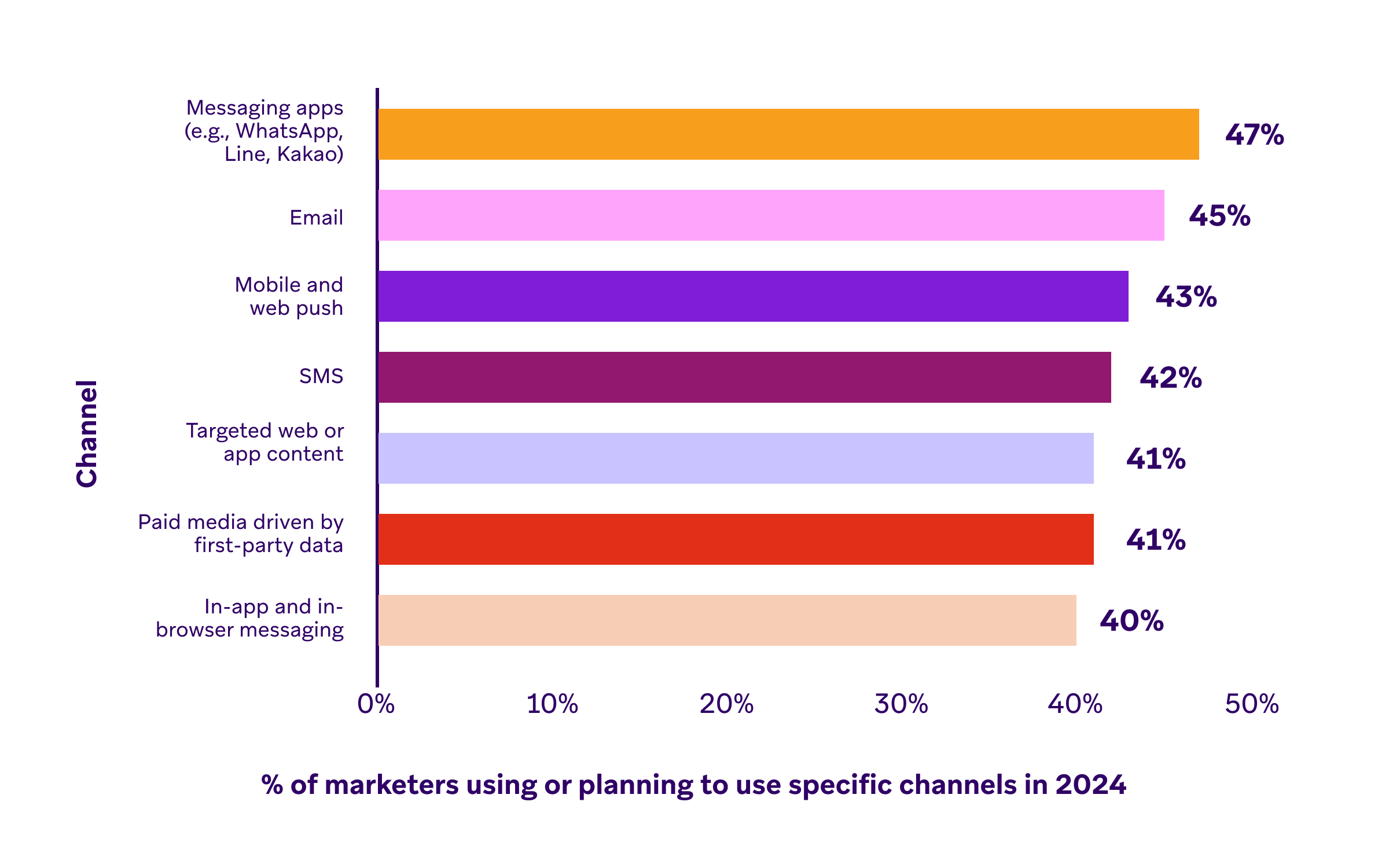
This aligns with two broader trends we are seeing in the market— first, brands want to diversify their channel mix by adding more channels, and second, marketers are looking for ways to connect with their customers where they already are, specifically on the channels they’re already using to talk to family and friends. Marketers across regions are interested in leveraging the channel. WhatsApp had the highest or second highest interest across regions, trailing only email in the US and EMEA. WhatsApp is already prevalent in LATAM, APAC, and EMEA, but the fact that marketers in the US are nearly as interested in WhatsApp as other regions indicates that there’s a large percentage who are not currently using the channel but planning to start in the near term.

Brands are seeing WhatsApp as one of their top-performing marketing channels
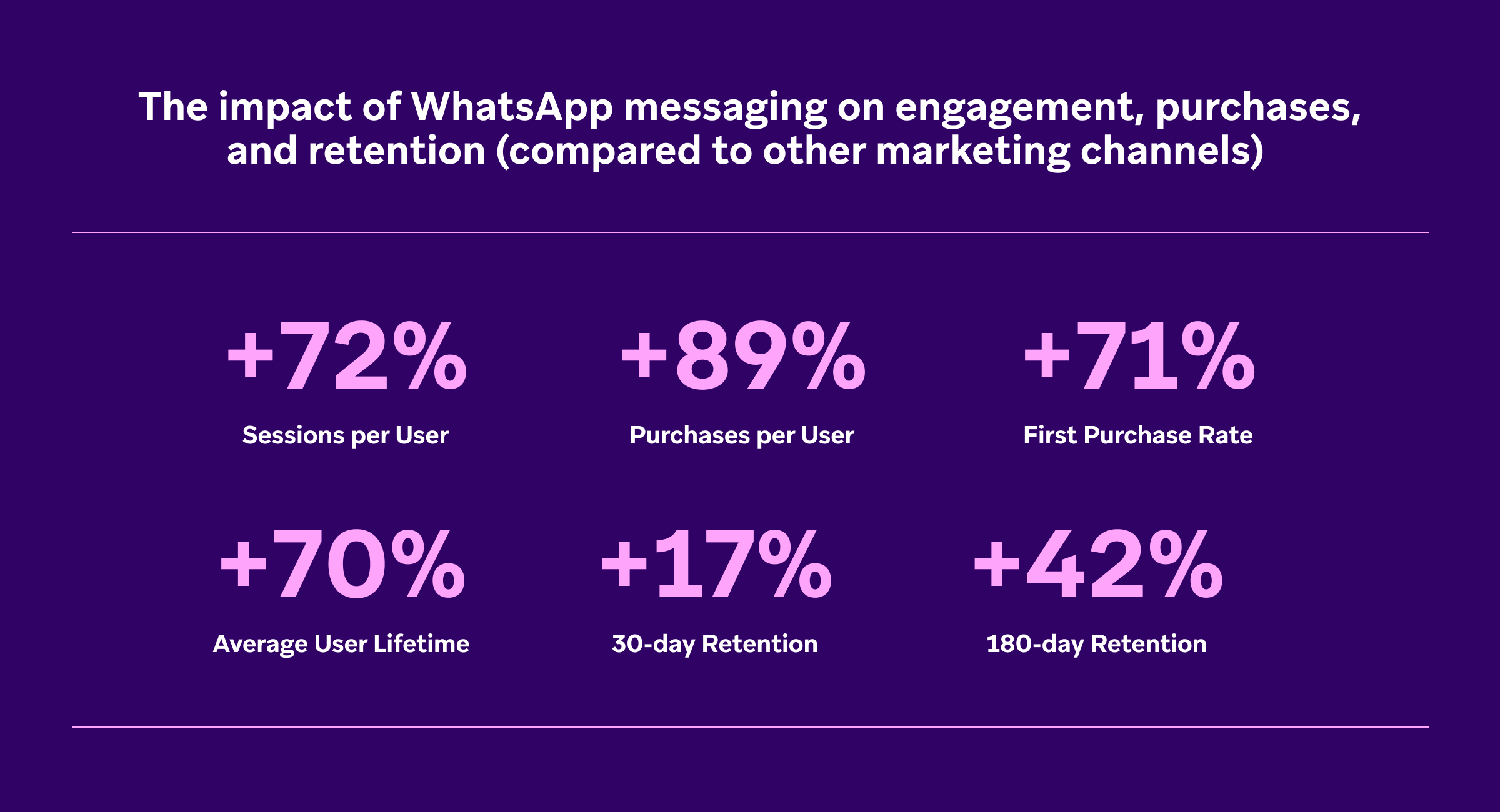
WhatsApp is a unique and dynamic channel that offers marketers new ways to engage their customers with eye-catching, interactive 1:1 messaging experiences. Because of WhatsApp’s rich capabilities, it’s no surprise that it drives more sessions and purchases than other marketing channels, on average. With WhatsApp, brands can capture their customers' attention by sending messages with quick reply buttons and dynamic calls-to-action that drive users back to their app or website. For brands in the financial services and health and wellness industries, they can use WhatsApp to encourage clients to use their services more often.Compared to other marketing channels, WhatsApp drives 72% higher sessions per user. The channel is especially effective at driving purchases with an 89% uplift in purchases per user over other channels. Retail and eCommerce and QSR brands can provide inspiration with rich imagery of their products and facilitate easier ordering experiences using quick reply buttons. But WhatsApp marketing isn’t just reserved for specific industries. The standout impact for those in Media and Entertainment or Travel and Hospitality is long-term retention. WhatsApp drives 42% higher 6-month retention than other channels. For brands in these industries, consider using the channel to recommend personalized content and send more transactional messages that provide utility—like booking reminders and account updates.
WhatsApp is most effective when used as part of a cross-channel engagement strategy
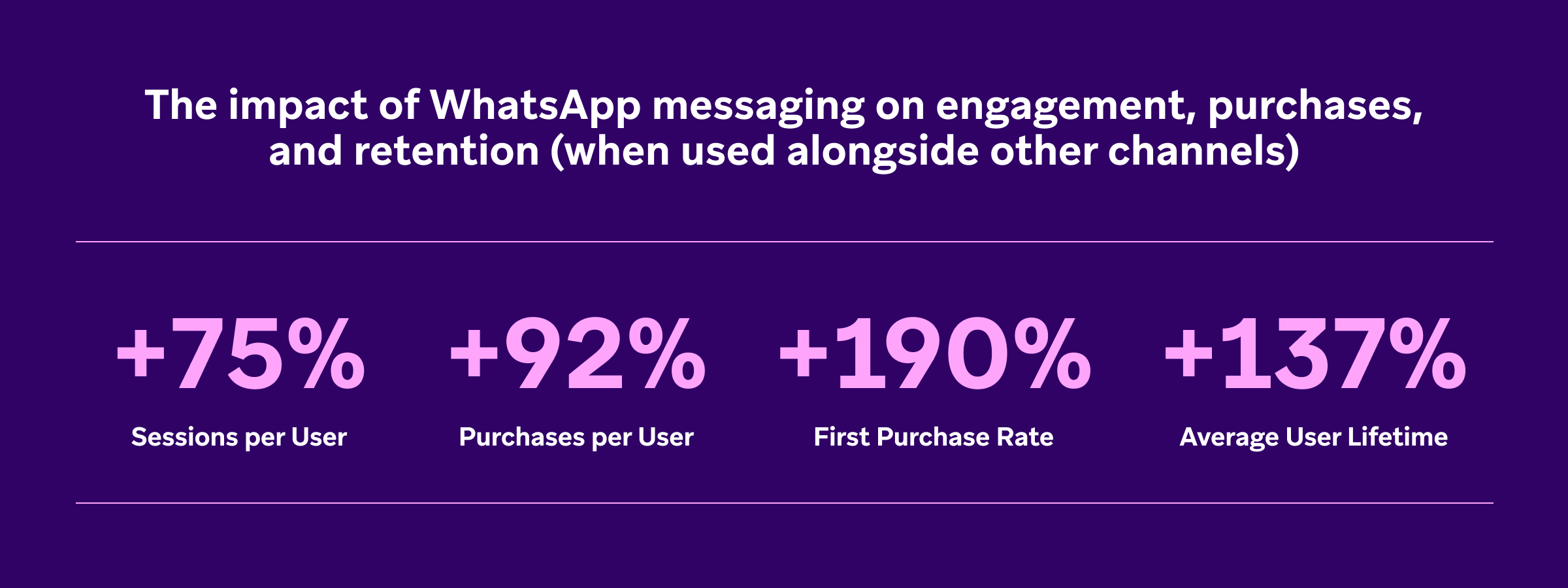
We’re seeing brands leverage WhatsApp best by seamlessly incorporating it into their existing channel mix to boost performance. Customers receiving WhatsApp also engage on average with messaging across three other channels. Despite already engaging with messaging across multiple other channels both in-product and out-of-product, receiving messaging from WhatsApp is correlated with an increase in engagement, purchases, and retention. Most notably, customers who received WhatsApp messaging were 190% more likely to make a purchase than customers who only received messaging from other channels. Leveraging more channels increases the chances of successfully reaching customers where they are.
If a customer also receives messaging from SMS, you can trigger WhatsApp messaging when a customer hasn’t interacted with SMS for several days. An even better approach is to map out a customer journey across different channels, giving each a distinct purpose based on its strengths. You can also leverage BrazeAI™ tools like Intelligent Channel and Personalized Paths to help ensure customers are receiving the most relevant messages on the channel they prefer.
Check out how Rappi leveraged WhatsApp to increase purchases from active users by 80% and purchases from lapsed users by 28%.
WhatsApp’s rich conversational capabilities boost performance
Two-Way Messaging
Two-way conversational messaging is a standout capability of WhatsApp—but it’s not the only way for this channel to be effective. Across Braze customers, two-way conversational messaging drove a 17% higher session start rate and a 2% higher purchase rate than one-way messaging. This data suggests that while two-way messaging may be an effective way to drive users back to your app, for example, to complete onboarding or make an update to their account, one-way messaging may be just as effective for promotional campaigns where you are looking to drive a purchase.
The key takeaway: The channel can effectively be used for both, depending on your goal and use case.
Here’s an example of how a two-way conversation can add unique value.
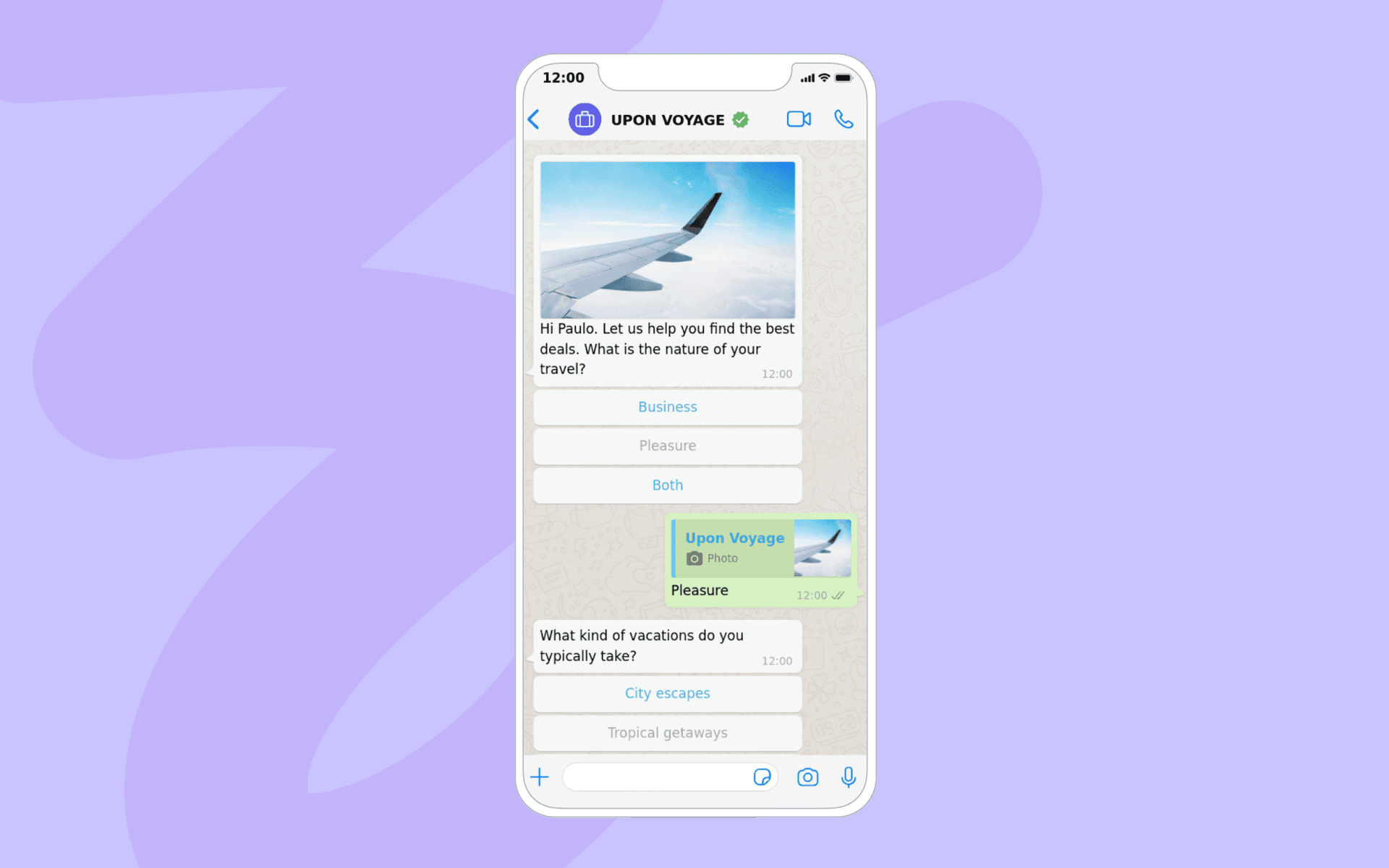
Rich Media
Rich media can help make WhatsApp messaging more engaging. WhatsApp messages that included media (e.g. images, videos) had a 46% higher purchase rate than those that did not. When highlighting apparel, food, shows, or travel destinations, an image will tap into customers’ emotions and interests much more than just text. Even for financial services and health and wellness brands, an image of a doctor or advisor can create a more human connection and help put customers at ease.
Key takeaway
While WhatsApp is a newer marketing channel for many regions and industries, it’s a promising tool that brands can use to deepen relationships with their customers. Braze customers across all regions and industries are seeing strong value based on their key metrics. From read-rates to long-term retention, WhatsApp is one of the top-performing marketing channels. To get the most out of WhatsApp, marketers should come up with a strategy on how the channel fits in their channel mix and how they should interact with customers with the capability of real-time two-way conversational messaging.
Learn more about leveraging WhatsApp as a marketing channel.
Footnotes:i Increase is comparing the First 3 months since launch vs the most recent 3 months ii Other channels is referring to the average across SMS, Email, Mobile Push, Web Push, IAM, and Content Cardsiii A total of four channel mixes were included in this analysis and the presented statistics are an average of the uplift from the four channel mixes.
- Email IAM Mobile Push vs Email IAM Mobile Push WhatsApp
- Email IAM vs Email IAM WhatsApp
- Email Mobile Push vs Email Mobile Push WhatsApp
- Email vs Email WhatsApp
Methodology: For this analysis Braze looked at anonymized and aggregated messaging and engagement data from 26 Braze Customers sending consistent WhatsApp messaging across the specified time period. These statistics cover messages sent between January 1, 2023–December 31, 2023. By using volume and company count checks, we have ensured that no one brand or group of brands is over-represented. All channel comparison metrics are based on the engagement of users who received messaging from the specified channels. All campaign comparison metrics are based on the conversion events tracked at the campaign level by the customer’s specified conversion criteria and window.
Related Tags
Be Absolutely Engaging.™
Sign up for regular updates from Braze.
Related Content
View the Blog
How behavioral marketing turns data into personalized experiences

Team Braze

Are you AI-savvy enough to survive? A wake-up call for CMOs

Team Braze
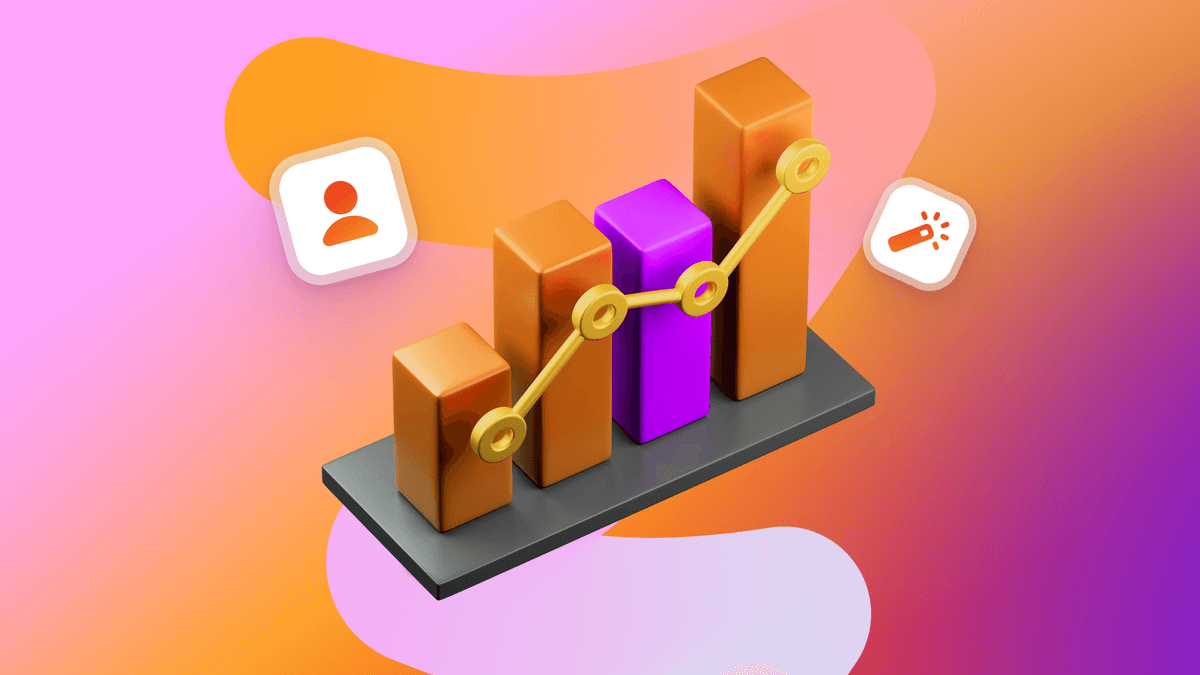
What are contextual bandits? The AI behind smarter, real-time personalization
